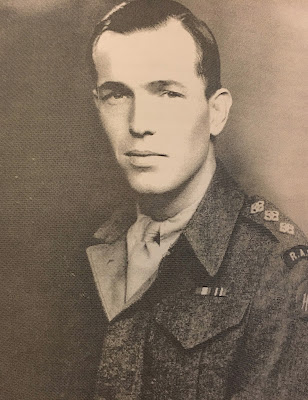When war started in Hong Kong on Monday 8 December it was Wiseman's 24th Birthday. He was responsible for the Vehicle Collection Centre (VCC) at Happy Valley. Two days after the Japanese landings he was ordered to relocate the Transport Pool to Sassoon Road, Pokfulam. Here he was shot in his un-amputated leg by friendly fire. There is a reference to his being wounded in the RASC war diary.
During this night of heavy rain (20th/21st December), fire from Tommy Guns of Indian units on Sassoon (Road) was sporadic especially on the occasion that a visit to Miramare’s telephone was necessary and in the house itself Capt Wiseman was wounded. (Source: Lt Howell, RASC War Diary).
 |
| Cover of Bill Wiseman's book (Veterans Publications, 2001) |
 |
| Captain Bill Wiseman (from the book) |
 |
| HMS Cicala in dry dock (Writer's Collection) |
Another interesting sketch was of WDV French. This launch was one of the WD (War Department) vessels operated by the RASC, under the blue ensign. French was used in the evacuation of troops from Devil's Peak Peninsula and throughout the period of hostilities.
 |
| A fine looking launch - WDV French (From Bill Wiseman's Book) |
After being wounded, Bill Wiseman was admitted to the nearby Queen Mary Hospital. In the next bed was Major Charles Boxer, the head of the combined forces intelligence unit. Boxer, a Japanese linguist, was well known to the Japanese from his liaison role with the Japanese Army. He received visitors from senior Japanese officers who were impressed when Major Boxer introduced Captain Wiseman and implied that he had lost one leg and been wounded in the other during the fighting.
From Bill Wiseman's book I discovered that Captain John ("Jack") Gordon Whitaker Adjutant of 5th AA Regiment, Royal Artillery, had married Wendy Winnifred Willcocks in Hong Kong shortly before the war. He was held in military POW camps and she was incarcerated in Stanley Camp with her parents Major James Lugard Willcocks and Muriel Kathleen Willcocks. A quick search of old Hong Kong newspapers revealed that the marriage between Jack Whittaker and Wendy Willcocks took place at St John's Cathedral on 25 October 1939. A reception was held at the Hong Kong Club Annex and the honeymoon was in less than exotic Fan Ling. H.E. the Governor was represented at the wedding by his Aide-de-Camp Captain Sydney Batty-Smith. Batty-Smith died in February 1945 whilst interned at Stanley Camp.
Major Willcocks was born in India the son of an Indian Army officer. Major Willcocks had served with the Black Watch in WW1 during which he was awarded the DSO and MC. He married Muriel Price in 1916. Their daughter Wendy was born in Bermuda in 1919. She was 22-years-old when she was interned at Stanley Camp. Major Willcocks was serving as Commissioner of Prisons in 1941 and was a member of the HKVDC. He commanded the Stanley Force and was the right hand man for Brigadier Wallis in the Battle for Stanley.
Bill Wiseman also mentions Lt. Michael H. Turner who was married to fifty-three-year-old Daisy Turner who was incarcerated in Stanley Camp with her married daughter Beryl Daisy Skipwith (nee Turner). They shared a room in the Indian Quarters with Joyce Bassett. Bill Wiseman writes that Lt Turner was known as "Pop" in POW Camp on account of his age (thought to be around 55). He had been the Head of prominent law firm Deacons before the war and the family had lived in a villa at Skek-O. He had been called to serve as a 2nd Lt in the 5th AA Regiment, Royal Artillery in 1941. His daughter Beryl Daisy had married Captain Patrick Skipwith, Adjutant of 8th Coast Regiment based at Stanley Fort.
Joyce Bassett had been a secretary working for the Colonial Secretariat. She had been based at Government House during hostilities. Her widowed mother Florence Eva Thornhill was also in Stanley Camp. Her bother Sub-Lt John Thornhill was serving with HKRNVR and was incarcerated in POW camp.
Joyce Bassett had been a secretary working for the Colonial Secretariat. She had been based at Government House during hostilities. Her widowed mother Florence Eva Thornhill was also in Stanley Camp. Her bother Sub-Lt John Thornhill was serving with HKRNVR and was incarcerated in POW camp.
...........
No comments:
Post a Comment